Loss and Reclamation: Rebuilding 1980s-Era BMX Bikes
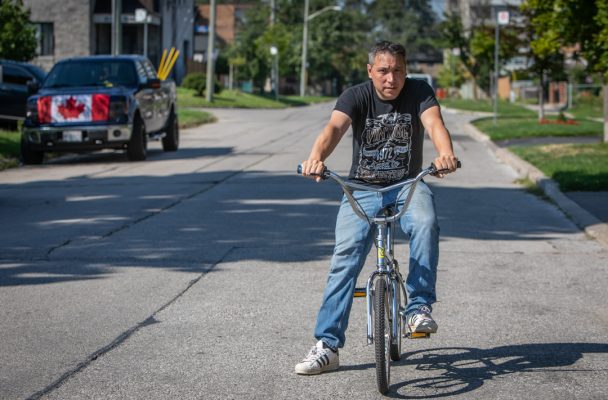
An interview with Toronto’s Cash Lim
By Robert Brodey
Nostalgia is a funny thing, particularly as we get older. Growing up in Toronto in the 1980s, I wasn’t particularly fond of the music being played on the radio (or at least I didn’t openly admit to people that I liked Cindy Lauper, White Snake, or George Michael), I hated acid wash jeans, and sometimes I wanted Scotty to beam me up from my awkward lanky teenage years.
But time and the complexity of adulthood has softened me and looking back at the era of my youth suddenly seems more hopeful and stylistically coherent. Big hair, vibrant-coloured balloon pants, and lots of synth now make perfect sense to me. Although BMX bikes were already the shit growing up, I never did get to own one. Still, they were a symbol of the 80s, made more iconic by Elliott’s Kuwahara bike in the movie E.T. the Extra-Terrestrial (1982).
Now I’m getting to the point of the story: quite recently, I was at my friend, Cash Lim’s, 50th birthday party and found out he had a side passion for rebuilding 1980s BMX bikes, sourcing authentic parts from the era. The next day, he sent me some photos, and my nostalgic heart skipped a beat.
Over the course of a month or so, I plugged him with questions.
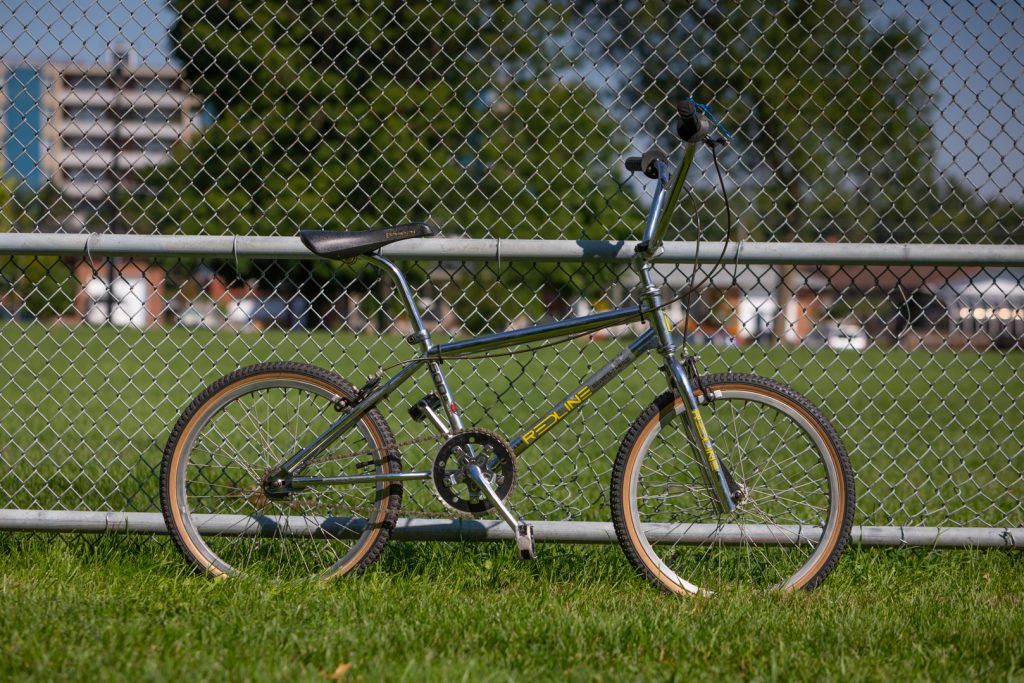
Before we get into the nitty-gritty of the BMX bikes you’ve rebuilt, can you lay down a bit of a backgrounder on what you do for your bread and butter?
Most of my time is spent on animation and VFX production work. Working as a producer with various studios over the years, I’ve been part of some really cool projects like The Peanuts Movie, Rock Dog, and the Ice Age series, as well as some work on the Minions and Secret Life of Pets properties. Day to day is pretty full-on with production issues and meetings, but I always find time to listen to music and mix tracks – I’ve been a DJ for almost 35 years and still enjoy coming up with dope hooks.
So how did you go from mixing tracks and doing animation production to rebuilding vintage BMX bikes?
I was working from home after starting my own production company and found myself more stressed than usual with the day-to-day grind of production. With the added weight of finding projects to keep the bills paid, I needed to find a way to separate myself from the work.
Without the commute or down-time you’d get from going into an office, I found that I was working at least 60-70 hours a week and busting my butt all through the night to keep clients around the world happy. One weekend, sometime in 2009, I decided to clean out the furnace room and saw the tire of my old 1988 Haro Master sticking out among a pile of junk. I had lent that bike to my nephew years earlier and thought it was gone, but somewhere along the line I had gotten it back and it ended up behind the furnace for almost 20 years.
It’s funny, because I missed that bike not realizing I had it the whole time…There’s a song in there somewhere. Anyway, I pulled out the bike and cleaned off all the dust, took it apart, and assessed what I needed to do to make it whole again. It was a good way to re-focus my mind away from production. I’d start working on that bike and before I knew it, hours had passed, and I hadn’t thought about anything production related.
In the end, I’m goal driven. I’m also very focused when I’m doing something I enjoy so the process of stripping down and cleaning up a bike is almost therapeutic and gives me the instant satisfaction of accomplishing something. Sourcing parts and putting it all back together is the cherry on top.
So it’s 2022. How do you go about sourcing authentic BMX parts from the 1980s?
For the most part, I research what the bikes originally looked like and how they were setup, digging through the forums on BMXmuseum, Ebay, Kijiji, or Google. Then I research how to identify certain bike part numbers and buy them. I quickly realized how expensive some of these parts can be and how hard some are to find. Luckily, the Haro Master wasn’t too bad because it was a common bike with a lot of easily obtainable parts. I re-built the Norco Spitfire with parts that I liked as a kid and would’ve wanted on my bike back then – if I had had the money.
Some of the other BMXs I’ve rebuilt don’t necessarily have exact original parts, but I make sure that the year is correct and if it had Lee Chi brakes then I’ll find a pair from that year.
Do you ride these BMX bikes or are they more like art pieces?
I ride them all. There’s a lot of people in the neighbourhood that appreciate these old bikes and like to stop and talk about the ones they rode growing up — how they used jump ramps in the field behind the abandoned factory or whatever.
Coincidentally, I just took my nephew down to the boardwalk at Woodbine Beach (in Toronto) to ride the Martin Goodman Trail, and a guy stopped us to admire the bikes. I was riding the Haro and my nephew was on his Redline. He commented that his first real bike was a Redline 500a and then outta nowhere he exclaimed, “Are those Pro Class rims!?!” If simply going out for a blast on the bike brings someone some joy, then I want to be a part of that.
Cash, I know you grew up in a working-class neighbourhood in Scarborough (a suburb of Toronto) and that it helped shape you into the person you are today. Can you talk a bit about that.
I was born in 1972, so the 1970s and 80s really shaped me. My family didn’t have a lot of money, and we moved back and forth between Toronto and Scarborough, until we finally ended up in a bungalow in Scarborough. My dad, who came to Canada from China in the 1950s, worked 3 jobs as a single parent for most of my childhood, and he did his best to support 4 kids while keeping us out of trouble. I was the youngest and the only boy.
When I was 4 years old, one of my older sisters was severely disabled after a car accident, and she has spent her entire life in a wheelchair unable to care for herself. As if life wasn’t already challenging enough for my dad…
When my dad was at work, us kids all depended on each other to care for ourselves and my sister, and I think we did a pretty good job! That definitely shaped me to be financially independent but also seriously family oriented. My dad always put family before himself and taught me that if you can help someone in need, you should. Even strangers.
Growing up poor, there was no money for extras, certainly not bikes. But one summer my dad surprised me with a Supercycle Super Cat from Canadian Tire (a Canadian retail chain). It wasn’t a major brand, but it was new, and it was mine. I rode it all summer until it got stolen outside of the movie theater while I was watching Back to the Future. My dad wanted to buy me a new one but didn’t have the money, so I was that kid who’d run alongside the other kids on their bikes (I became very fast with lots of stamina, which came in handy later in life).
Are you nostalgic about your childhood now, and how have your feelings about the past changed through time?
For sure. I’ve always been nostalgic and sentimental, but I’m finding that more and more I’m appreciating the life I lived. My mom left when I was 8 years old, shortly after moving to Scarborough. I remember standing on the porch with a cup of tea I had made for her, watching her drive away. I was really sad at first, not understanding why she was driving away with a bunch of stuff in her car. Then as I got a bit older, maybe around high school, I was angry about it and even told new friends that she was dead. Now that she’s gone, I really wish that I hadn’t said that. I really loved my mom.
Overall, I don’t remember being happy as a kid but little things I’ll see, hear, or smell trigger memories that seem to tell me that I was. I hear the song Take my Breath Away by Berlin, and I’m instantly transported back to the summer of 1986 in the neighborhood park with my friends. Or I smell Lavender, and I’m 6 years old again, using my mom’s hand cream to slick my hair back so I could look like my dad.
That’s some pretty heavy stuff. OK, now let’s get specific and talk about these BMX gems of 1980s nostalgia. Tell me about some of your favourite bike builds to date.
1988 – Haro Master
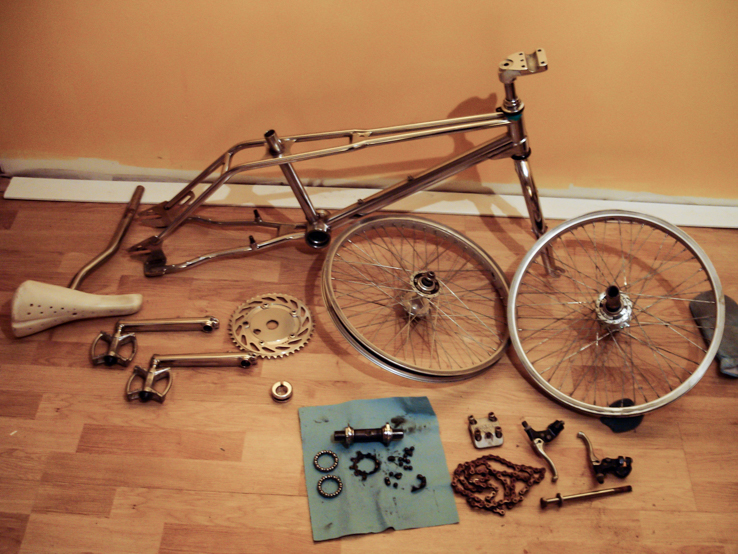
Photo by Cash Lim.
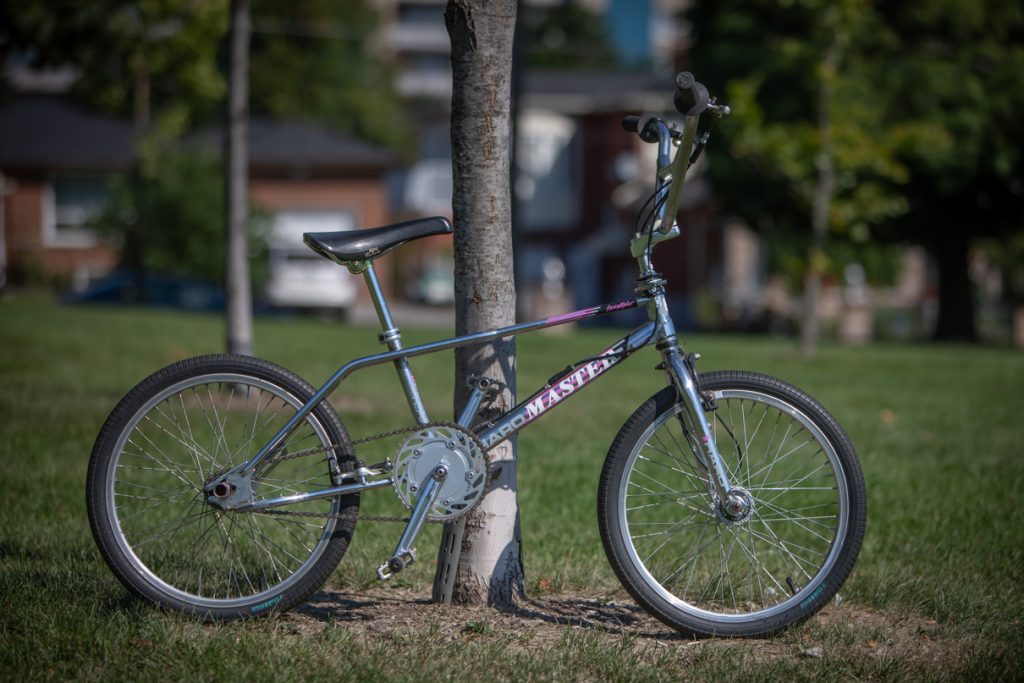
Photo by Robert Brodey
I liked the Haros but when I was a kid I wanted a PK Ripper, Trick Star, or a Redline. For me, they were rich kid bikes and a bit out of reach. In high school, someone had left a Haro at a party at my friend’s place. I rode it home the next morning, and it kinda made its rounds over the rest of the school year with different people using it to get around. It was in decent shape, then one guy’s dog ate the seat, another friend left it in the rain, adding rust, and someone else for some reason gave the back brake and front fork standers away.
As mentioned previously, it sat behind the furnace in the basement mixed in with junk for years until I found it and did a massive overhaul. It was pretty beat up and missing some parts, including the rear brake, rotor, handlebar grips, tires, bottom bracket bearings, and chain. It had also been stripped to the chrome, so it had no decals. I had to find about 30% of the parts online and at bike shops around the city.
It’s kind of cool, because at first I was just going to replace the bottom bracket bearings and ride it. But when I went to a bike shop called CORE on Queen Street, the owner asked me what I planned to do with the bike. I said I just wanted to ride it again. I think it struck a chord with him – seeing that I just wanted to enjoy this bike for nostalgia’s sake — because he started finding parts around the store and gave them to me — things like the grips, brake pads, and cables. He gave me a bunch of other stuff at a discount. Some parts weren’t exactly original but that was OK, because I just really wanted to ride it.
At the time, I had no idea about the whole old school BMX community that was out there. Some are more particular, and some are more like me, where if it’s pretty close, slap it on, and go ride. As much as I try to use original parts, I realize that authentic grips and rubber tires aren’t lasting 35+ years, so some compromises have to be made.
This rebuild took about a year.
1985 – Norco Spitfire
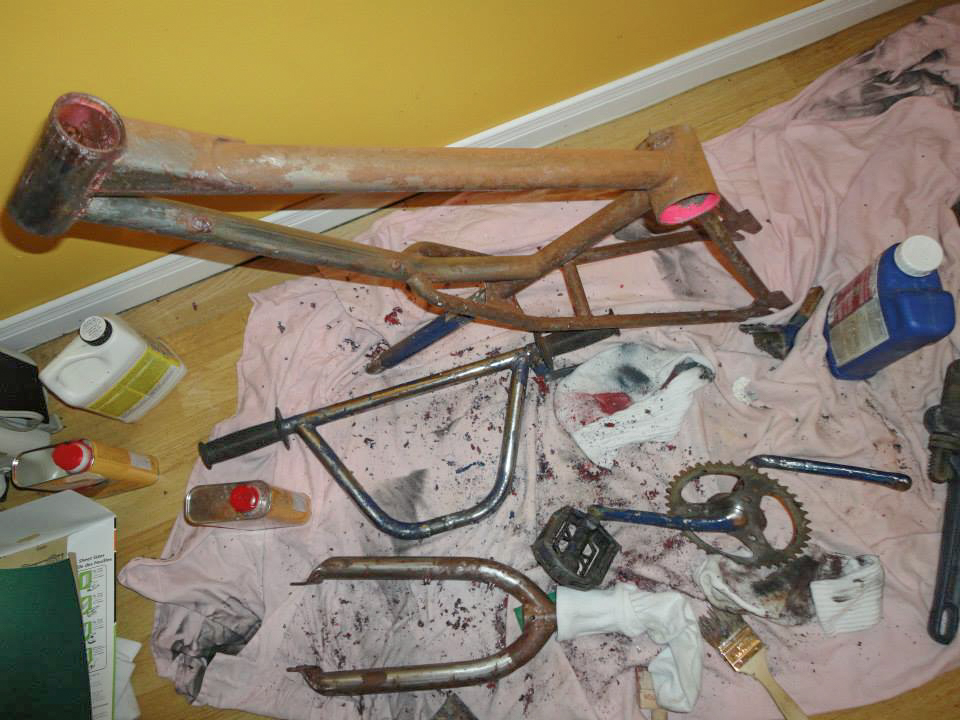
Photo by Cash Lim
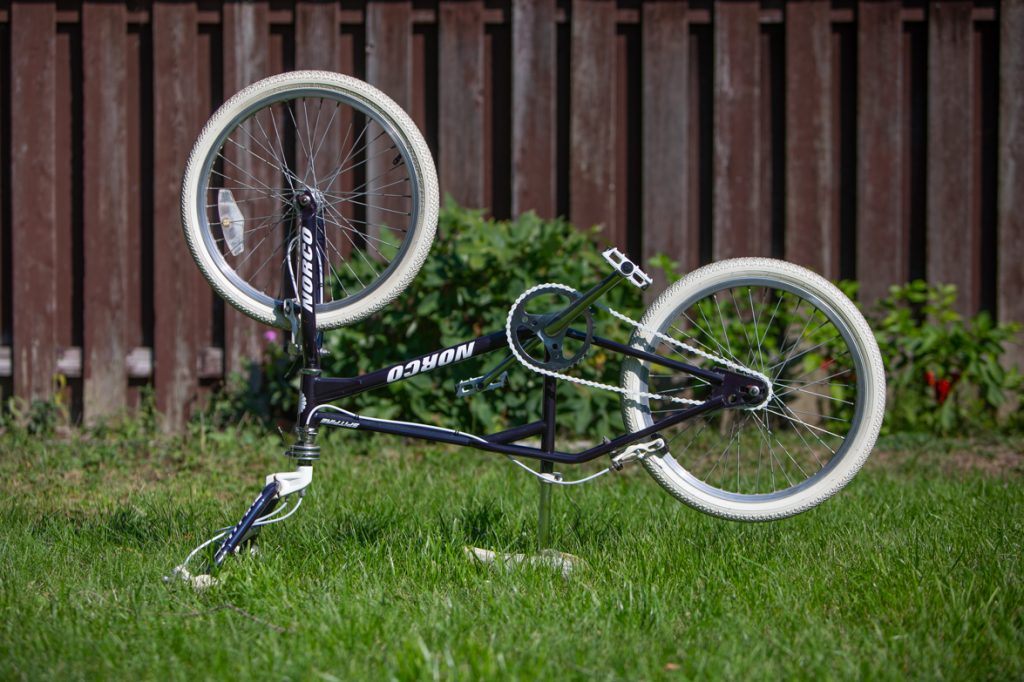
Photo by Robert Brodey
I found this frame and forks in the trash one evening on the way to my car after work. Immediately, I felt like it was something that I could bring back to life. Perhaps, it wasn’t something others would see as salvageable, but I saw past the rattle can paint and rust. I actually didn’t know what kind of bike it was but thought it could be a Dyno or GT of some sort. When I looked online, though, I realized it wasn’t. So, I started scanning through old BMXs, checked serial number conventions, and narrowed it down to the Norco Spitfire.
I spent 2 years sourcing parts and rebuilding it. I built this one with all the parts I would’ve wanted back in the 80s so nothing’s original to the bike. The rotor and levers are ACS with Bulldog calipers and Cool Stop pads. I also found a really clean pair of Mongoose Pro Class for this build. The stem is a knock off Redline Forklifter.
I painted it Batik Blue to match my VW GTI.
1988 – Peregrine Pro
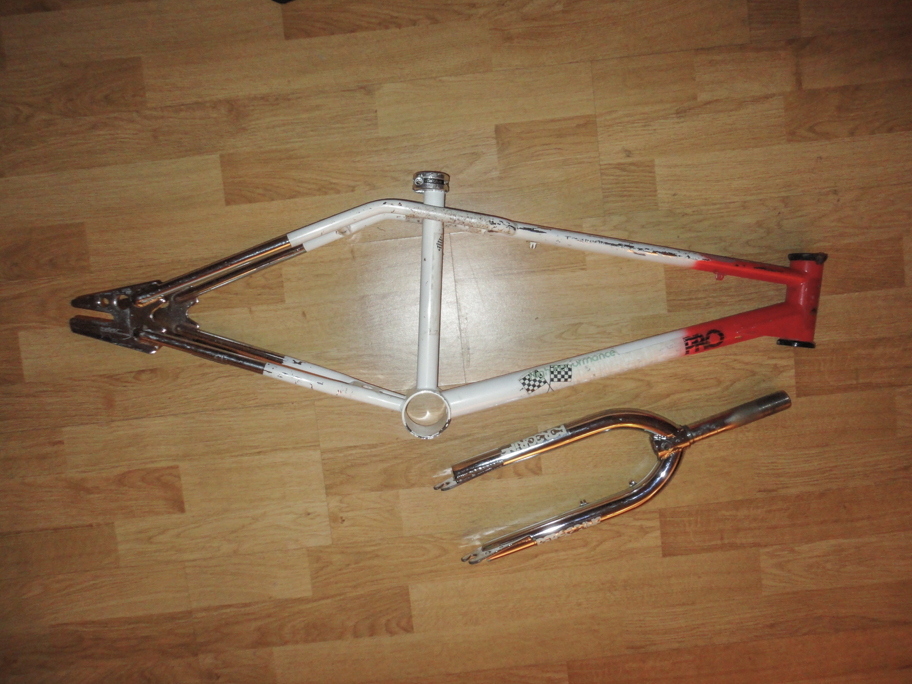
Photo by Cash Lim
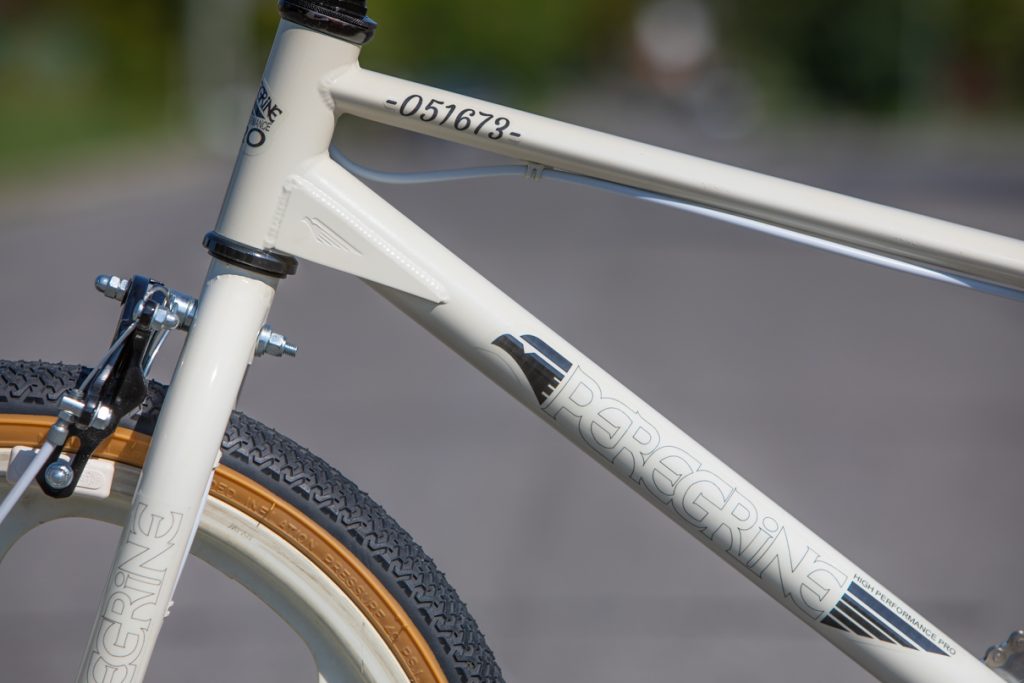
Photo by Robert Brodey
Not all the bikes I’ve built were for me. The 1988 Peregrine Pro, for instance, was being re-assembled for my best friend Colin, who was my first friend when I moved to Scarborough in the summer of 1980. We rode bikes around the neighborhood when we were younger but as we got to middle school, we both got really into skateboarding, because boards were much cheaper than BMX bikes. As we got older, our passion for music grew pretty deep, and we both got into DJing, and, in many ways, he was a driving force behind many of the things I succeeded at.
I started this bike in 2013. Colin had been living on the west coast for years, and I’d go out and visit him regularly. One time, I flew him back to Toronto so we could catch up on our home turf. Shortly before he arrived, I told him I was looking for another bike to build, and he mentioned that the old Peregrines were cool. I felt the same and searched for one — not telling him that I wanted to build it for him so he would have something to ride during future visits to Toronto. When he arrived, we drove straight to Buffalo from the airport to pick up the frame and forks that I bought online.
After he left, and over the next couple years, I stripped and resprayed it Titanium White and searched for parts based on his suggestions. I was going to put some Peregrine 48s on it, but he said that this one never came with them so we should look for some Peregrine Masters. It was mostly finished but I had to find the wheels, or it wouldn’t be right for him. I regularly updated him on the progress, as it was something we really enjoyed talking about.
Then, in January 2016, while I was in southern Florida riding motorcycles, I got the terrible news that Colin had died unexpectantly that morning. After that, I lost all interest in working on the bike, in part because he wasn’t there to share the process. I decided not to finish it, so it collected dust for a while, until one day I randomly got an email with a Kijiji ad for a pair of Peregrine White Master rims that were really cheap. For some reason this gave me the spark to work on Colin’s bike again. I designed custom decals, found the rest of the parts I needed, and I finally finished it on his birthday in 2019. Even though Colin never got to see the bike, I think he would have really loved it.
I turned it in to a memorial bike with Colin’s birth and death date on the top tube. I’ve never ridden it.
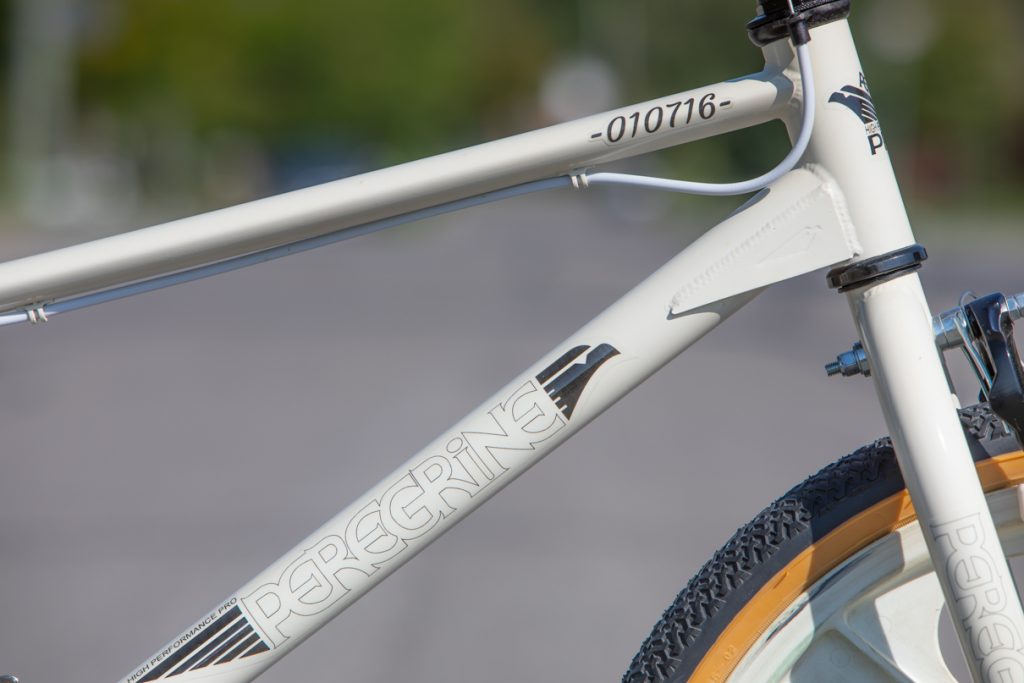
Photo by Robert Brodey
1984 – Redline MXIII 500a
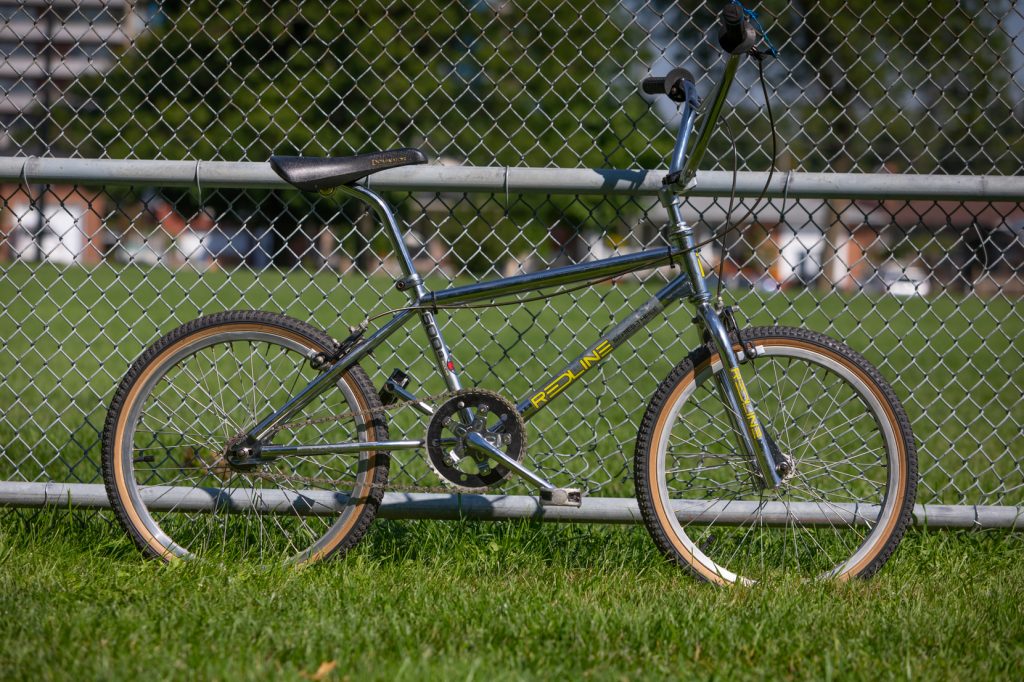
Photo by Robert Brodey
I built this for my nephew Courtney, who was born in 1984. He loved the Redline I had back in the 80s when he was a kid (Well, technically not mine, but I rode it a lot!). For years, he always talked about the chrome Redline with Mongoose rims. So this build is 90% original with 10% sourced 1984 parts. It even had the store’s sticker still on it. The tires on the rims were modern but were replaced with old school gum wall snake belly tires before I gave it to him.
When I’m rebuilding bikes, I like to go with authentic time-period parts that are specific to the bike model, but for this BMX, my nephew wanted Mongoose Pro Class rims, so I went hunting for them. I eventually found some from 1986 in Montreal, which was 2 years off — but beggars can’t be choosers, right? Courtney also wanted front and rear MX brakes, which didn’t come on that particular model, so I had to source a pair of 1984 MX brakes, which was no easy task. It took me about 8 months to track a pair down. In total, this ride took about a year to build.
1989 – Mongoose M1
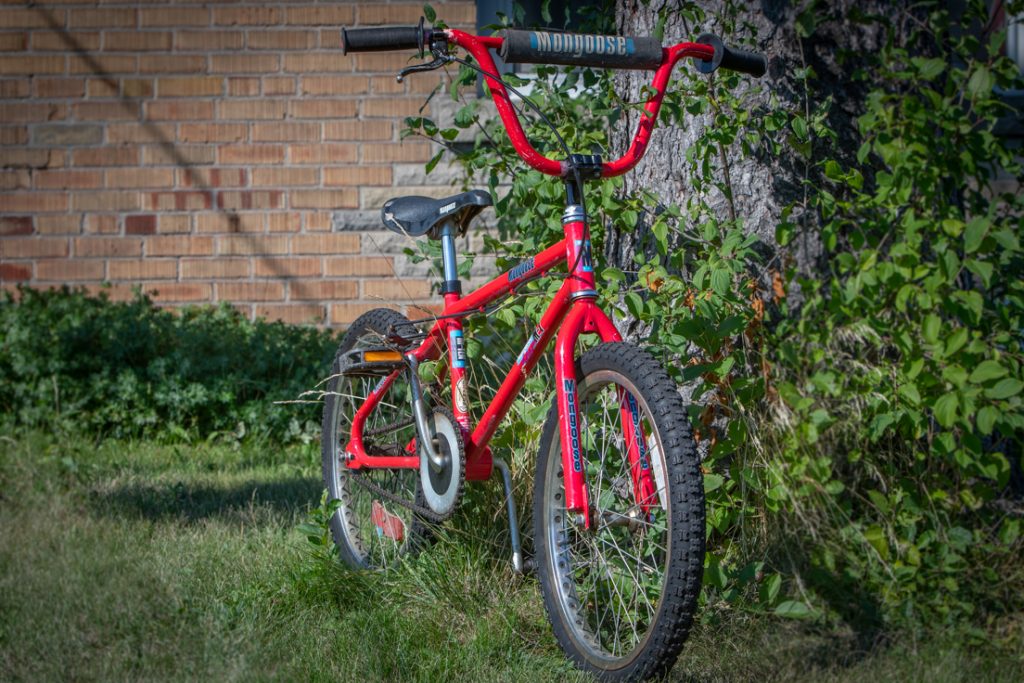
Photo by Robert Brodey
From her birth year, this bike was built for my wife Sarah so she could ride with me.
This one was a 100% survivor, so all I did was put it back together and clean it up a bit.
I always really liked the Mongoose. I saw the BMX movie Rad in 1986 and got totally hooked. The media certainly has a way of baking long lasting impressions into young malleable minds! I found this Mongoose at the time I was looking for my nephew’s Redline, so I grabbed it. Sarah was accustomed to watching me fill the living room with bikes and parts, so how better to get her onboard by building her something that she could ride. Even better, it was red and had coaster brakes! The front wheel reflector isn’t original, but she likes it. I even put a soft cover over the seat because she “doesn’t understand why they make these things out of hard plastic.”
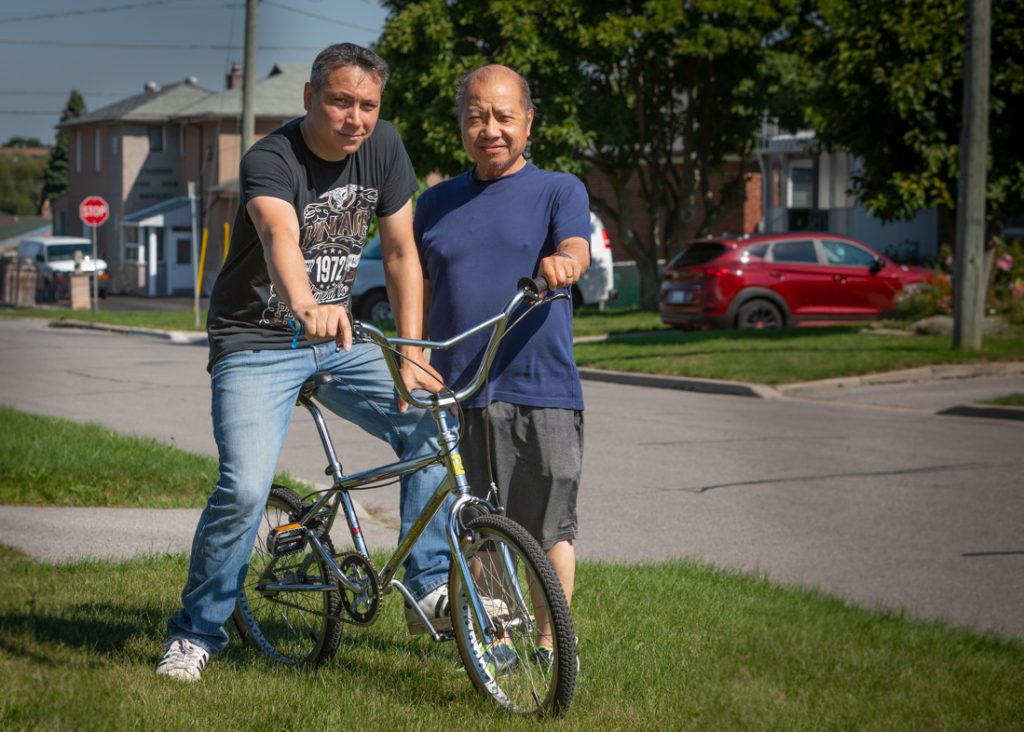
Photo by Robert Brodey
*This interview has been edited for length and clarity.
Leave a Reply
You must be logged in to post a comment.